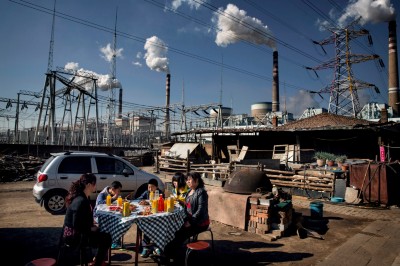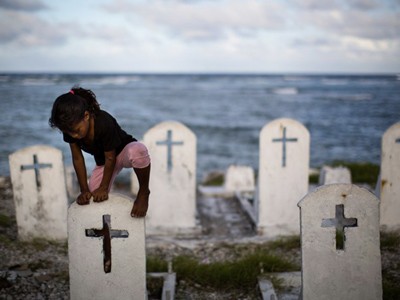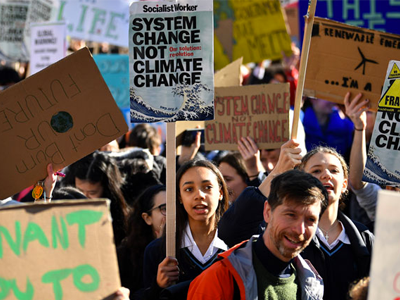
A 23 September United Nations summit coincides with a week of global strike action organised by climate activistsCredit: Alain Pitton/NurPhoto via Getty
There isn’t much that focuses the mind like a deadline. Just ask any journalist, or indeed anyone working for a government. The story of politicians and climate change is partly one of decision makers putting off hard choices. But that can’t go on for much longer. As zero hour approaches, there can be no more kicking of climate cans. The time to act is now.
That’s why Nature has joined Covering Climate Now, a collaboration between the world’s media organizations. For one week, starting on 15 September, Nature and more than 250 other outlets — with a combined audience of more than one billion — have committed to a week of intensive climate coverage (scroll down to see a list of our coverage, which will be updated throughout the week).
Along with many other journals, Nature and other publications in the Nature family have reported the science and policy of climate change for decades. Our reporters covered the first meeting of the Intergovernmental Panel on Climate Change (IPCC) in Geneva, Switzerland, in 1988, and our journalism, expert commentary and research continues to reveal the consequences of a warming planet and explore options for how humanity could adapt.
The hard truths of climate change — by the numbers
Last year, the IPCC warned that limiting global warming to 1.5 °C above pre-industrial levels would be a colossal undertaking, requiring greenhouse-gas emissions to be cut in half by 2030. The transition to renewable energy alone would cost US$2.4 trillion annually. And yet, without such drastic measures, the world is likely to exceed 3 °C of warming by the end of the century, and will experience more frequent and more severe catastrophic effects, including weather extremes, rising seas and drought. Scientists on the meteorological front line see temperature records continually broken, and this is leading to despair: from watching the natural world deteriorate before their eyes, and from continued inaction by heads of government despite compelling evidence of the importance of intervention.
World leaders — to a large extent constrained by a desire to protect fossil-fuel industries — continue to play for time. But the window for action is shrinking, so something different and more urgent must be done. Covering Climate Now leads up to the United Nations climate summit in New York on 23 September. This meeting will be hosted by UN secretary-general António Guterres, and his instructions to world leaders are to come only if they have concrete commitments for a full transition to sustainable development. The UN summit coincides with a week of global strike action organized by climate activists and young people.
Imperative for action
Covering Climate Now is unusual, ambitious, timely and welcome, not least because it is rare to see often highly competitive media groups collaborating for a shared purpose.
One of our articles reveals how countries are progressing towards their obligations under the 2015 Paris climate agreement. Sadly, greenhouse-gas emissions continue to climb, even as nations pledge to make substantial reductions. The one glimmer of hope is that energy from renewable sources is now growing faster than that supplied by fossil fuels. However, fossil-fuelled power continues to rise at a rapid rate, and its share of the global energy supply far eclipses that of renewables.
Where climate cash is flowing and why it’s not enough
Countries also pledged to make substantial climate investments — but here, too, the scorecard is mixed. In 2017, more than half a trillion dollars was spent on climate finance, but most of this was expended by governments and businesses in wealthy countries, on behalf of wealthy countries. By contrast, $57 billion of public money flowed from developed to developing countries in the same year — around three-quarters of which was in loans, not grants. Without more financial support, those in countries that have contributed the least carbon pollution are projected to suffer the most.
An urgent situation demands urgent solutions, and new ideas continue to emerge. Across the world, lawmakers are coalescing around Green New Deal plans — including massive public investment in decarbonizing all economic sectors, not just energy. The Green New Deal is ambitious, not least because it promises a swift end to fossil fuels and requires the state to reclaim those parts of the economy — notably energy and infrastructure finance — in which the public sector of many countries has been less active for something approaching 40 years.
Why I broke the law for climate change
The idea is controversial. Michael Mann, director of the Penn State Earth System Science Center in University Park, Pennsylvania, is sympathetic to the Green New Deal, but is not quite ready to downplay the contribution of the market. By contrast, Kevin Anderson at the Tyndall Centre for Climate Change Research at the University of Manchester, UK, thinks that time has run out for what he calls “incremental decarbonizing of the free-market economy”. Farhana Yamin, an environmental lawyer, has gone a step further. After three decades as an academic, adviser to governments and the UN, and a member of the IPCC, she has joined Extinction Rebellion, a movement that organizes non-violent civil disobedience, and explains why direct action is now the only solution.
Individuals and organizations worldwide, including Springer Nature, Nature’s publisher, are wrestling with how to cut their carbon emissions, through travel and other means. Biologists Olivier Hamant, Timothy Saunders and Virgile Viasnoff lay out a seven-point plan for making conferences more sustainable, including a recommendation for organizers to consider holding fewer, longer and more in-depth meetings. They also have advice for principal investigators: take slower forms of transport, and let younger colleagues travel instead.
Scientists worldwide join strikes for climate change
Last month, teenage climate activist Greta Thunberg did just that by sailing into New York harbour after a two-week transatlantic crossing to attend the UN climate summit. One sail featured the phrase ‘Unite Behind the Science’. Along with our colleagues in Covering Climate Now, we are united with all those who stand behind the consensus view of researchers. But there can be no more delay. The time to act is now.

 Meet the weather observers on climate change’s front lines
Meet the weather observers on climate change’s front lines
 ‘Ecological grief’ grips scientists witnessing Great Barrier Reef’s decline
‘Ecological grief’ grips scientists witnessing Great Barrier Reef’s decline
 Dramatic sea-ice melt caps tough Arctic summer
Dramatic sea-ice melt caps tough Arctic summer
 African nations push UN to improve drought research
African nations push UN to improve drought research
 Computing a hard limit on growth
Computing a hard limit on growth




